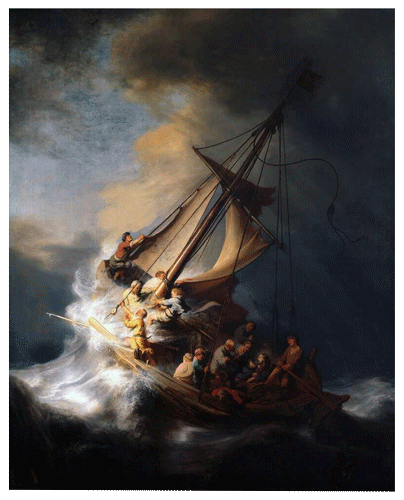Sherwin Rivera Tibayan
AGAIN AND AGAIN IN THE SAME WAY FOREVER
Storm (after Rembrandt), 2020
Animated GIF, 30 found JPEGS
Can we say that Rembrandt’s Christ in the Storm on the Sea of Galilee, stolen thirty years ago, is still here with us? That right now it’s physically intact and recognizable somewhere in the world? Maybe it was hastily rolled up and buried deep in the ground decades ago, too hot to handle, somewhere in New England, and the only people who knew have long-since passed. Or maybe, at this very moment, it’s hanging quietly in a private residence, re-stretched, re-framed, and reminding someone so undeserving of the company that, even during pandemic times, the old adage that we’re all in the same storm, but not on the same boat, rings true. Or worst of all, it’s neatly filed away in the climate-controlled limbo of the Geneva Freeport, noted cryptically on a spreadsheet, tax free and removed from the public interest. And the rest? Where are the other paintings, drawings and sculptural objects—twelve unlucky apostles— taken, purloined, vanished from the Isabella Stewart Gardner Museum late on March 18, 1990?
It’s worth noting that in March 1989, a year before the heist, Tim Berners-Lee, a computer scientist at CERN in Geneva, Switzerland, first proposed and began working on an idea for a “World Wide Web.” By August 1991, the Web became publicly available on the Internet, and by 1992 the first photograph was uploaded to servers, followed by so many others.
My guess is that there’s some sort of ur-photo of Christ in the Storm at the Gardner Museum. It might be a color slide in an archival box or sleeve, locked away from light and humidity, but still in the company of the other missing artworks. I like to imagine that the Gardner had a salaried in-house photographer when the 1980s turned into the 1990s. A person who cared about how the artworks might be translated accurately and evocatively to film for academic use and public posterity, as an aid to the art and not its replacement. But I can also imagine that maybe those pictures were taken on a day when the marketing team could schedule a commercial photographer to come by with a sturdy tripod and some lights. Brochures need pictures too.
However they were made, and under whatever labor conditions they were produced in, sometime after 1:30am on that night in March, as the sun was beginning its annual transition north across the equator—momentarily balancing the hours of night and day—those images were also in the midst of a crossing over.
When you visit the private-mansion-turned museum—another kind of crossing over— to see for yourself where Christ in the Storm was last seen, you will be in the “Dutch Room,” standing in front of a large wall covered in a heavy floral drapery. Other paintings and artworks are there. But your eyes will eventually come to see a rather large, decorative wood frame; its four corners circumscribe an emptiness. You are in part asked to understand this scene, this encounter, as both the site and the sight of a significant loss. I visited the museum in 2018. I saw this too. I looked at the wall flowers and the empty frame; only it was a garden bed.
The Gardner published a slim book about the heist. In the foreword they write:
When thieves robbed the Gardner of some of its greatest masterpieces, they deprived all of us of the chance to be a part of this ongoing conversation. They relegated these objects to the past, to memory, far from the everyday encounters that keep them vital and connect them to our lives today. That is why the Gardner theft is so often described as a crime against humanity. That is why it is essential that these works be returned to the pubic. And that is why we at the Isabella Stewart Gardner Museum will never cease in our efforts to recover these objects and display them once again in their rightful home….
It’s a full-throated and recognizably humanistic mission statement on behalf of “these objects,” one that equates cultural necessity to material essentialness. And the mission in the statement is the searching. It’s a type of searching that reflects and magnifies our own current compulsions and values. Not searching as an action performed to completion, or that might eventually be called off, but as an attitude—present in the incessant blinking of a cursor waiting for text—that’s unaddressed ad infinitum. It’s late in the game, and this searching is beginning to look like procrastination.
But what if we were moved to walk away from this quagmire of actions and beliefs—that these objects are still with us, somehow still discoverable after an entire generation of searching? Could we find solace and firmer ground in the knowledge that they once existed in our world, exquisitely, and no longer? What if we acknowledged the artworks’ objecthood as a property that could and does vanish over time, like our own?
At the inflection point between material and immaterial cultures, and perfectly matched for the coming technological moment, Christ in the Storm’s sudden invisibility thirty years ago also hastened an unveiling. The speed of a scanner’s light passing over a wafer thin rectangle of color film was all that was needed to achieve the necessary escape velocity. I can’t tell you the exact date it occurred, but it’s no small irony that the Gardner Museum’s never-ceasing quest for the return of antique masterworks—opulent, corporeal, and currently valued at $500 million—essentially required them to make the works as contemporary, as compressed, and as worthless as networked technologies could produce for a global public. A jpeg is no Rembrandt, and that’s not a crisis.
In fact, with its material corollary completely vanished before its digital self was ever uploaded and made transmittable, the web images of Christ in the Storm displayed on our screens all these years never once functioned as the synchronous documentation of a physical artwork. Without this relationship, they only and ever completely existed as web art—and perhaps some of the earliest and most bountiful too.
Every year in March, when winter turns to spring in the northern hemisphere, another batch of think pieces and posts and status updates and reappraisals about the Gardner theft are produced. The writers remind us about that night, how the hours were the early morning kind, that maybe it was the mob, and that maybe just maybe, this could be the year. All the usual words are accompanied by the images: a new crop of jpeg varieties scattered across planetary-wide servers, copied and shared, manipulated, embedded, resplendent in shifting, garish colors and harmful artifacts; each iteration a new file name and location, with altered dimensions and metadata made suitable and searchable for the automated slideshow or the text-graphic mashup.
These pictures, in the end, have been our perennials: always returning, always refreshing, and always reminding us that this art—like any art—is the consolation we make for the vengeance of being here and now.

